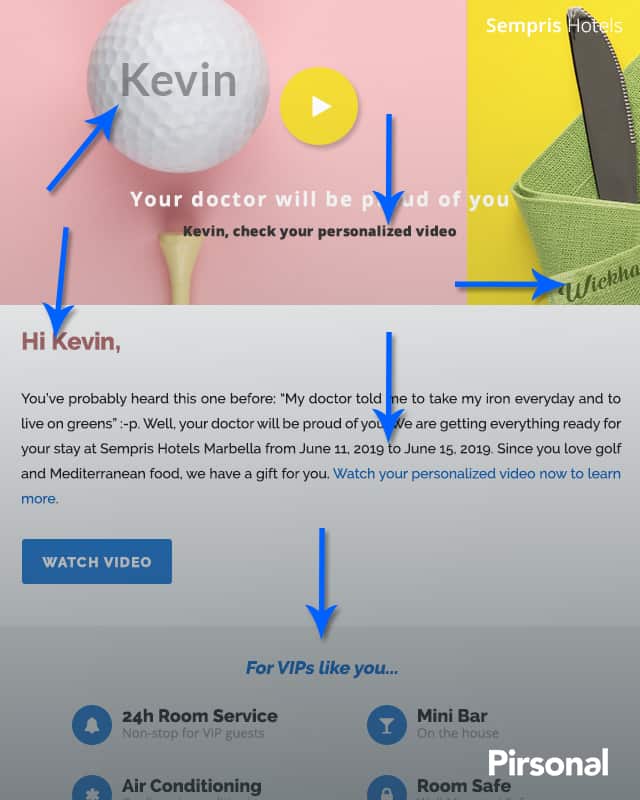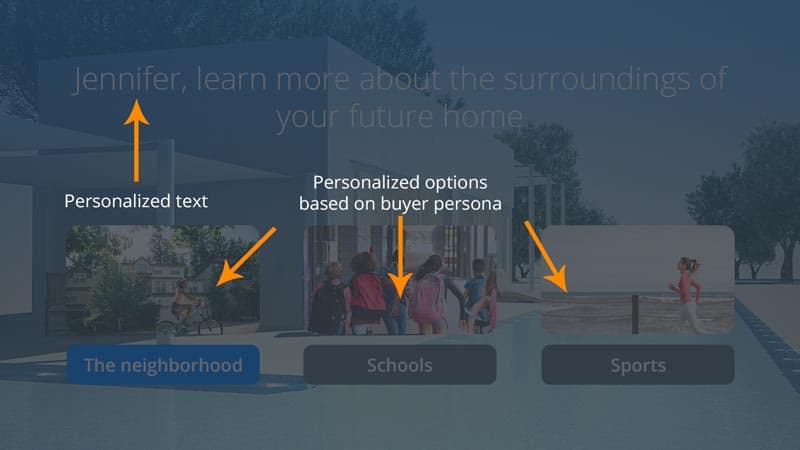For many marketing teams, creating a video marketing strategy can be hard. Even if they are experienced. Video marketing has emerged as a powerful tool for businesses to engage with potential customers and drive sales. This is why it is important to have a clear understanding of how to boost sales with video marketing. But let’s keep it simple.
To create a simple video marketing strategy that boosts sales, start by setting clear goals, identifying your target audience, and creating engaging content. This includes selecting the right format, writing captivating scripts, and utilizing visuals and editing techniques.
To make sure your videos get seen on social media, first, optimize them for search engines. Then, publish and promote them on the right platforms, like social platforms and email marketing.
However, a robust video marketing strategy incorporates other strategic elements like performance analysis. Also, if the videos are meant for one-to-one marketing, then you also need to master personalization.
Keep reading to learn how to develop a simple but effective video marketing strategy to enhance your sales and business performance with one-to-many and one-to-one strategies.
Video Marketing
Video marketing has revolutionized the way businesses communicate with their customers. It allows you to convey your brand message, showcase products or services, and build a deeper connection with your target audience. In this article, we will explore the key steps to creating an effective video marketing strategy that drives results.
Understanding the Importance of Video Marketing
Before diving into the strategy, it’s crucial to understand why video marketing is essential for your business. Video content is highly engaging and can captivate your audience’s attention more effectively than text or images alone.
Let’s talk about theory. In Customer Experience (CX), there are four key dimensions that affect how we all interact with different types of content.
Generally speaking, the more dimensions an interaction implies, the more effective the content and channel is.
Well, video is the type of digital content that uses more of these dimensions at the same time. This is one of the reasons why video marketing is so effective.
The sensory appeal of the customer experience in video marketing is the way a video stimulates the senses. Hence, the sensory appeal has an impact on the perceptions of product performance. At the same time, this moves potential buyers into the sales funnel.
Likewise, this dimension relates to the perception of viewing beauty. And video is the best multimedia content to make this happen.
As a result, video helps you convey emotions, demonstrate product features, and tell compelling stories that resonate with your viewers.
Additionally, videos have a higher chance of being shared on social media, expanding your brand reach and visibility.
Defining Your Target Audience
To create a successful video marketing strategy, you need to identify and understand your target audience.
Who are your ideal customers? What are their demographics, interests, and pain points? By gaining insights into your audience’s preferences, you can tailor your videos to resonate with them on a deeper level.
Here you have an easy way to segment your audiences:
Even better, the different buyer personas your organization already targets. This will help you tailor your messaging, creative content, and distribution platform based on what will be more effective.
Setting Goals for Your Video Marketing Strategy
To track the progress of your video marketing strategy, you need to establish measurable goals and track them using relevant marketing metrics.
In marketing, metrics are measurable values that demonstrate how well a particular aspect of your marketing strategy is performing.
Analyzing your video campaigns with data can help you make informed decisions to improve their effectiveness and ensure maximum impact.
What do you want to achieve with your video marketing strategy?
Is it to increase brand awareness, generate leads, drive website traffic, or boost sales? Setting clear and measurable goals will help you determine the metrics to track and evaluate the success of your strategy.
If you measure these metrics against particular KPIs, even better. That way, you’ll know if your video marketing strategy is working or not.
Creating Compelling Video Content
The heart of any video marketing strategy lies in creating compelling and engaging content. Here are the key steps to follow:
Choose the Right Video Format
Consider the different types of videos you can create, such as explainer videos, product videos, product demonstrations, customer testimonials, or educational content.
Each format serves a specific purpose, so choose the one that aligns best with your goals and resonates with your audience.
Crafting a Captivating Script
A well-crafted script is essential for delivering a powerful message in your videos. It should be concise, engaging, and structured to keep your viewers hooked from start to finish.
Incorporate storytelling elements and highlight the benefits your product or service offers.
Utilizing Visuals and Editing Techniques
Visuals play a vital role in video content. Use high-quality footage, images, animations, and graphics to enhance the visual appeal of your videos.
Leverage editing techniques, such as transitions, overlays, and text animations, to make your videos more dynamic and engaging.
Optimizing Your Videos for Search Engines
To maximize the visibility of your videos, it’s crucial to optimize them for search engines. Follow these steps:
Keyword Research and Optimization
Conduct keyword research to identify relevant keywords and phrases related to your video content.
Incorporate these keywords naturally into your video titles, descriptions, and tags to improve search engine rankings and attract organic traffic.
Craft Attention-Grabbing Titles and Descriptions
Create compelling and concise titles that entice viewers to click and watch your videos. Craft keyword-rich descriptions that provide a clear overview of what your video offers and why viewers should watch it.
Consider the global audience when creating content or messages by adding localization to your video marketing strategy through social media channels.
It’s essential to use language, imagery, and cultural references that are universally understandable and relatable.
By doing so, you can engage and connect with a broader audience and foster a positive brand reputation both domestically and internationally.
Add Relevant Tags and Metadata
Tags and metadata help search engines understand the context of your videos.
Add relevant tags that describe the content and include additional metadata, such as category, location, and language, to optimize your videos for search.
Publishing and Promoting Your Videos
Once your videos are ready, it’s time to publish and promote them effectively through social media platforms, email, or messaging services like WhatsApp.
Consider the following strategies:
Select the Right Video Hosting Platform
Choose a video hosting platform that suits your needs and aligns with your marketing goals.
It’s important to determine if your videos will be used for one-to-many marketing on social media or as part of a one-to-one sales strategy.
For one-to-many, YouTube, Vimeo, and Wistia are popular video hosting platforms that offer various features and analytics to track performance.
However, in one-to-one marketing, it is better to utilize a platform meant to create and distribute hundreds, thousands, or even millions of videos with personalization.
Personalized videos are often created for specific customers. But, since these videos are personalized for each customer, you will usually end up with as many videos as the customers you have.
Here you have a personalized video example:
Personalized video platforms like Pirsonal are meant to host and share as many personalized videos as you need. A big advantage of these types of videos is that since the video is personalized for a customer, you can track analytics and engagement individually.
Sharing Videos on Social Media
If your video marketing strategy follows a one-to-many approach, leverage the power of social media to amplify the reach of your videos.
Share them across platforms like Facebook, Instagram, Twitter, and LinkedIn, making sure to optimize the content for each specific platform.
Leveraging Email Marketing and Newsletters
Include your videos in your email marketing campaigns and newsletters. Embed videos directly in your emails or link to them on your website or video hosting platform.
But this also requires strategy. Before you embed a video in an email, make sure to watch the following video. It will help you know the challenges you’ll need to overcome and even if the strategy is the right one.
For example, in personalized marketing with video, I usually recommend displaying the video in a personalized landing page instead of embedding the video in an email.
Here is an example of an email with a personalized video:

The reason for this is that in personalized video marketing, you often want the lead or customer to take a particular action while, or after they have watched a video.
The best way to do this is by incorporating a personalized call-to-action button in the video. This is possible with Pirsonal’s interactive video player. This interactive video player allows you to have personalized calls-to-action (CTA) for any number of videos.
Here you have an example of an interactive video with a personalized CTA.

This makes your videos about 200% more engaging and effective.
However, if your goal is to increase branding or email interaction, then adding videos to emails can significantly boost click-through rates and engagement.
As you can see, there are many ways you can use video online. But if you are planning on using them as part of an email marketing campaign, make sure to know how to optimize them for maximum impact according to your goals, metrics, and KPIs.
Watch the following video to learn more about this:
Analyzing and Measuring Video Performance
It is critical to know how to optimize your marketing. To refine your video marketing strategy, you need to analyze and measure the performance of your videos. Follow these steps:
Track Views-Through Rate, Engagement, and Conversions
For social videos, monitor the number of video views, likes, comments, and shares your videos receive. Track engagement metrics, such as watch time and click-through rates.
Track the outcome of one-to-one videos by measuring the number of views, the percentage of the video each lead or customer watched or video-through rate, and the rate of engagement with in-video calls-to-action.
Additionally, in both cases, measure how your videos contribute to lead generation, conversions, and sales.
Use Analytics Tools to Gain Insights
Utilize video analytics tools provided by hosting platforms or third-party tools like Google Analytics.
These tools offer valuable insights into viewer behavior, audience demographics, and audience retention. Use these insights to refine your future videos and optimize your strategy.
Engage with Your Audience Through Video
Video allows you to establish a more personal connection with your audience. Foster engagement by:
Encouraging Comments and Feedback
Invite viewers to leave comments, ask questions, and share their opinions. Respond promptly to their comments to foster a sense of community and build trust.
Responding to Audience Inquiries and Messages
Monitor your social media platforms and email inbox for messages and inquiries related to your videos. Provide timely and helpful responses, demonstrating your commitment to customer satisfaction.
Incorporating Video into Your Sales Funnel
Video can play a crucial role in every stage of your sales funnel. Consider the following strategies:
Creating Product Demonstration Videos
Showcase your products or services through engaging and informative demonstration videos. Highlight their features, benefits, and unique selling points to drive conversions.
Developing Customer Testimonials and Case Studies
Feature satisfied customers in testimonial videos or case studies. Let them share their positive experiences and the results they achieved with your products or services.
Using Video in Email Marketing Campaigns
Integrate videos into your email marketing campaigns to increase engagement and conversions. Include personalized video messages or embed relevant videos directly in your emails.
Collaborating with Influencers and Industry Experts
Partnering with influencers or industry experts can expand your reach and lend credibility to your brand. If the marketing strategy is going to be executed by an agency or by another colleague under your supervision, make sure they have experience planning, executing, and optimizing marketing campaigns.
Collaborate on video content, such as interviews, collaborations, or sponsored videos, to tap into their audience and build trust with your target market.
Keeping Up with Video Marketing Trends
Stay up to date with the latest trends and innovations in video marketing. Explore emerging formats, technologies, and platforms to keep your video strategy fresh and engaging.
Experiment with new ideas while staying true to your brand identity and audience preferences.
Frequently Asked Questions (FAQs)
How long should my marketing videos be?
The ideal video length depends on the platform and the content you’re delivering. Short videos (under 2 minutes) work well on social media, while longer videos are better for detailed tutorials or webinars.
I recommend personalized videos be between 30 and 60 seconds long. However, longer videos can perform well depending on the type of content and funnel stage.
Videos that provide important after-sales and legal information can exceed the 60-second time limit and still be successful. This is because the content is essential for the viewer’s success.
Lead engagement videos should be even shorter than 30 seconds since contacts are not anticipating the video, and you need to capture their attention quickly.
Do I need professional equipment to create videos?
While professional equipment can enhance video quality, you can create compelling videos with a smartphone and basic editing tools.
Focus on delivering valuable content and engaging storytelling rather than solely relying on equipment.
If you need to make videos in bulk or as part of an automation workflow, then use specialized personalized and automated video editing software like Pirsonal.
Pirsonal is flexible, scalable, and robust so that you can make videos at scale automatically using CRM data, marketing automation workflows, or even data from a spreadsheet.
Can video marketing help improve my website’s SEO?
Yes, video content can positively impact your website’s SEO. By optimizing your videos with relevant keywords, video descriptions, and tags, you can improve your visibility in search engine results and drive organic traffic to your website.
Also, with video content, website visitors spend about two more minutes per session. This means that your website has a higher engagement and a lower bounce rate.
What are some effective video marketing strategies for small businesses?
Small businesses can leverage video marketing by creating engaging personalized videos, interactive videos, product demonstrations, customer testimonials, behind-the-scenes footage, or educational videos.
Additionally, partnering with local influencers or collaborating with complementary businesses can help expand their reach.
Is it necessary to hire a video production company for creating marketing videos?
While hiring a video production company can provide professional results, it’s not always necessary, especially for small businesses with limited budgets.
With the right planning, tools, software, and creativity, you can create compelling videos in-house or with the help of freelancers.
Conclusion
Creating a killer video marketing strategy requires careful planning, engaging content creation, strategic promotion, and continuous analysis.
To increase your sales and business growth with video content, it’s important to know your audience and set clear goals. You should also optimize your videos for search engines. By doing so, you can create a strategy that delivers real results.
For more personal marketing, use personalized videos. With Pirsonal’s scalable video personalization software, you can automatically create data-driven videos for customers.
Plus, our service team walks with you to help you succeed. Feel free to contact us now or request a free trial here.

